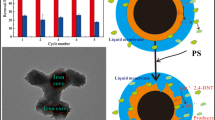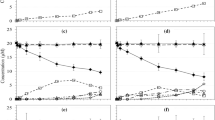Abstract
Remediation of contaminated groundwater by nanoscale zero-valent iron (nZVI) is widely becoming a leading environmentally friendly solution throughout the globe. Since a wide range of various nZVI-containing materials have been developed for effective remediation, it is necessary to determine an appropriate way to terminate the reactivity of any nZVI-containing material for a practical experimental procedure. In this study, bimetallic Ni/Fe-NPs were prepared to enhance overall reduction kinetics owing to the catalytic reactivity of nickel on the surface of nZVI. We have tested several chemical strategies in order to terminate nZVI reactivity without altering the concentration of volatile compounds in the solution. The strategies include surface passivation in alkaline conditions by addition of carbonate, and consumption of nZVI by a reaction competitor. Four halogenated chemicals, trichloroethylene, 1,1,1-trichloroethane, atrazine, and 4-chlorophenol, were selected and tested as model groundwater contaminants. Addition of carbonate to passivate the nZVI surface was not effective for trichloroethylene. Nitrate and then bromate were applied to competitively consume nZVI by their faster reduction kinetics. Bromate proved to be more effective than nitrate, subsequently terminating nZVI reactivity for all four of the tested halogenated compounds. Furthermore, the suggested termination method using bromate was successfully applied to obtain trichloroethylene reduction kinetics. Herein, we report the simple and effective method to terminate the reactivity of nZVI by addition of a reducing reactivity competitor.





Similar content being viewed by others
References
Badawi AF, Cavalieri EL, Rogan EG (2000) Effect of chlorinated hydrocarbons on expression of cytochrome P450 1A1, 1A2 and 1B1 and 2- and 4-hydroxylation of 17β-estradiol in female Sprague–Dawley rats. Carcinogenesis 21:1593–1599
Bae S, Lee W (2010) Inhibition of nZVI reactivity by magnetite during the reductive degradation of 1,1,1-TCA in nZVI/magnetite suspension. Appl Catal B Environ 96:10–17. https://doi.org/10.1016/j.apcatb.2010.01.028
Bardos P, Jones S (2015) Taking nanotechnological remediation processes from lab scale to end user applications for the restoration of a clean environment (NanoRem) Project Nr.: 309517 EU, 7th FP, NMP.2012.1.2
Barnes RJ, Riba O, Gardner MN et al (2010) Optimization of nano-scale nickel/iron particles for the reduction of high concentration chlorinated aliphatic hydrocarbon solutions. Chemosphere 79:448–454. https://doi.org/10.1016/j.chemosphere.2010.01.044
Chen H, Luo H, Lan Y et al (2011) Removal of tetracycline from aqueous solutions using polyvinylpyrrolidone (PVP-K30) modified nanoscale zero valent iron. J Hazard Mater 192:44–53. https://doi.org/10.1016/j.jhazmat.2011.04.089
Ghauch A, Tuqan A (2008) Catalytic degradation of chlorothalonil in water using bimetallic iron-based systems. Chemosphere 73:751–759. https://doi.org/10.1016/j.chemosphere.2008.06.035
Hwang Y, Kim D-G, Shin H-S (2011) Mechanism study of nitrate reduction by nano zero valent iron. J Hazard Mater 185:1513–1521. https://doi.org/10.1016/j.jhazmat.2010.10.078
Hwang Y, Lee Y-C, Mines PD et al (2014) Investigation of washing and storage strategy on aging of Mg-aminoclay (MgAC) coated nanoscale zero-valent iron (nZVI) particles. Chem Eng Sci 119:310–317. https://doi.org/10.1016/j.ces.2014.08.002
Hwang Y, Mines PD, Jakobsen MH, Andersen HR (2015) Simple colorimetric assay for dehalogenation reactivity of nanoscale zero-valent iron using 4-chlorophenol. Appl Catal B Environ 166–167:18–24. https://doi.org/10.1016/j.apcatb.2014.10.059
Hwang Y, Salatas A, Mines PD et al (2016) Graduated characterization method using a multi-well microplate for reducing reactivity of nanoscale zero valent iron materials. Appl Catal B Environ 181:314–320. https://doi.org/10.1016/j.apcatb.2015.07.041
Kim E-J, Murugesan K, Kim J-H et al (2013) Remediation of trichloroethylene by FeS-coated iron nanoparticles in simulated and real groundwater: effects of water chemistry. Ind Eng Chem Res 52:9343–9350. https://doi.org/10.1021/ie400165a
Li X, Elliott DW, Zhang W (2006) Zero-valent iron nanoparticles for abatement of environmental pollutants: materials and engineering aspects. Crit Rev Solid State Mater Sci 31:111–122. https://doi.org/10.1080/10408430601057611
Liu Y, Lowry GV (2006) Effect of particle age (Fe0 content) and solution pH on NZVI reactivity: H2 evolution and TCE dechlorination. Environ Sci Technol 40:6085–6090. https://doi.org/10.1021/es060685o
Liu Y, Phenrat T, Lowry GV (2007) Effect of TCE concentration and dissolved groundwater solutes on NZVI-promoted TCE dechlorination and H2 evolution. Environ Sci Technol 41:7881–7887. https://doi.org/10.1021/es0711967
Mackenzie PD, Horney DP, Sivavec TM (1999) Mineral precipitation and porosity losses in granular iron columns. J Hazard Mater 68:1–17. https://doi.org/10.1016/S0304-3894(99)00029-1
McIntyre T (2003) Phytoremediation of heavy metals from soils BT—phytoremediation. In: Tsao DT (ed) Advances in biochemical engineering/biotechnology. Springer, Berlin, pp 97–123
McKnight US, Funder SG, Rasmussen JJ et al (2010) An integrated model for assessing the risk of TCE groundwater contamination to human receptors and surface water ecosystems. Ecol Eng 36:1126–1137. https://doi.org/10.1016/j.ecoleng.2010.01.004
Mines PD, Byun J, Hwang Y et al (2016) Nanoporous networks as effective stabilisation matrices for nanoscale zero-valent iron and groundwater pollutant removal. J Mater Chem A 4:632–639. https://doi.org/10.1039/C5TA05025A
Nadagouda MN, Castle AB, Murdock RC et al (2010) In vitro biocompatibility of nanoscale zerovalent iron particles (NZVI) synthesized using tea polyphenols. Green Chem 12:114–122. https://doi.org/10.1039/B921203P
Nurmi JT, Tratnyek PG (2008) Electrochemical studies of packed iron powder electrodes: effects of common constituents of natural waters on corrosion potential. Corros Sci 50:144–154. https://doi.org/10.1016/j.corsci.2007.06.016
O’Carroll D, Sleep B, Krol M et al (2013) Nanoscale zero valent iron and bimetallic particles for contaminated site remediation. Adv Water Resour 51:104–122. https://doi.org/10.1016/j.advwatres.2012.02.005
Panagos P, Van Liedekerke M, Yigini Y, Montanarella L (2013) Contaminated sites in Europe: review of the current situation based on data collected through a European network. J Environ Public Health. https://doi.org/10.1155/2013/158764
Prokop G, Schamann M, Edelgaard I, Gentile AR (2000) Management of contaminated sites in Western Europe. European Environment Agency, Copenhagen
Ryu A, Jeong S-W, Jang A, Choi H (2011) Reduction of highly concentrated nitrate using nanoscale zero-valent iron: effects of aggregation and catalyst on reactivity. Appl Catal B Environ 105:128–135. https://doi.org/10.1016/j.apcatb.2011.04.002
Shi Z, Fan D, Johnson RL et al (2015) Methods for characterizing the fate and effects of nano zerovalent iron during groundwater remediation. J Contam Hydrol 181:17–35. https://doi.org/10.1016/j.jconhyd.2015.03.004
Squillace PJ, Thurman EM, Furlong ET (1993) Groundwater as a nonpoint source of atrazine and deethylatrazine in a river during base flow conditions. Water Resour Res 29:1719–1729. https://doi.org/10.1029/93WR00290
Theron J, Walker JA, Cloete TE (2008) Nanotechnology and water treatment: applications and emerging opportunities. Crit Rev Microbiol 34:43–69. https://doi.org/10.1080/10408410701710442
Tosco T, Petrangeli Papini M, Cruz Viggi C, Sethi R (2014) Nanoscale zerovalent iron particles for groundwater remediation: a review. J Clean Prod 77:10–21. https://doi.org/10.1016/j.jclepro.2013.12.026
Wang W, Jin Z, Li T et al (2006) Preparation of spherical iron nanoclusters in ethanol-water solution for nitrate removal. Chemosphere 65:1396–1404. https://doi.org/10.1016/j.chemosphere.2006.03.075
Wang Q, Snyder S, Kim J, Choi H (2009) Aqueous ethanol modified nanoscale zerovalent iron in bromate reduction: synthesis, characterization, and reactivity. Environ Sci Technol 43:3292–3299. https://doi.org/10.1021/es803540b
Zhang XL, Tao S, Liu WX et al (2005) Source diagnostics of polycyclic aromatic hydrocarbons based on species ratios: a multimedia approach. Environ Sci Technol 39:9109–9114. https://doi.org/10.1021/es0513741
Zou Y, Wang X, Khan A et al (2016) Environmental remediation and application of nanoscale zero-valent iron and its composites for the removal of heavy metal ions: a review. Environ Sci Technol 50:7290–7304. https://doi.org/10.1021/acs.est.6b01897
Acknowledgements
P.D.M. and H.R.A. acknowledge funding for this study from the Technical University of Denmark (DTU) through the KAIST-DTU Signature Project on Integrated Water Technology. Y.H. acknowledges fundings for this study though a DFF-Individual Postdoctoral Grant from the Danish Council for Independent Research—Technology and Production Science (4005-00393B) and “The GAIA Project” by the Korea Ministry of Environment (RE201402059). W.L. acknowledges funding supported by Korea Ministry of Environment (MOE) as “Geo-Advanced Innovative Action” Program (Project No. 2015000560002). We would also like to thank Wilhelmus Huyzer from the DTU Center for Electron Nanoscopy (DTU-CEN) for his assistance with the nanoparticle characterization.
Funding information
This study was funded by the Technical University of Denmark (DTU) through the KAIST-DTU Signature Project on Integrated Water Technology, a DFF-Individual Postdoctoral Grant from the Danish Council for Independent Research—Technology and Production Science (4005-00393B), and “The GAIA Project” by the Korea Ministry of Environment (RE201402059, 2015000560002).
Author information
Authors and Affiliations
Corresponding author
Ethics declarations
Conflict of interest
The authors declare that they have no conflict of interest.
Electronic supplementary material
ESM 1
(DOCX 107 kb)
Rights and permissions
About this article
Cite this article
Mines, P.D., Kaarsholm, K.M.S., Droumpali, A. et al. Termination of nanoscale zero-valent iron reactivity by addition of bromate as a reducing reactivity competitor. J Nanopart Res 19, 301 (2017). https://doi.org/10.1007/s11051-017-4000-x
Received:
Accepted:
Published:
DOI: https://doi.org/10.1007/s11051-017-4000-x




